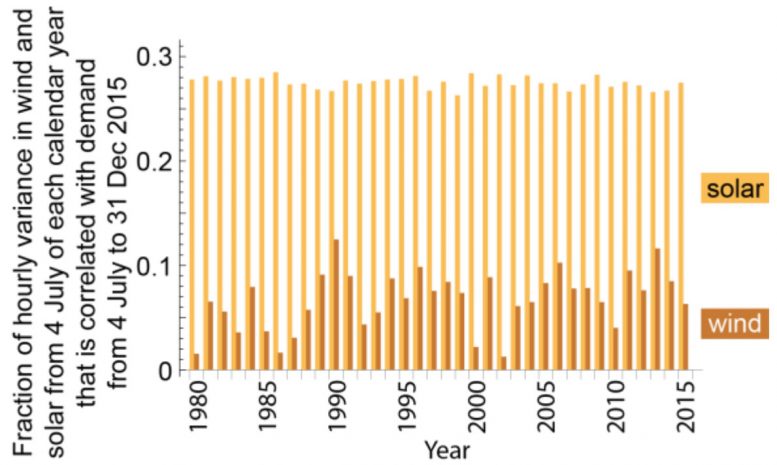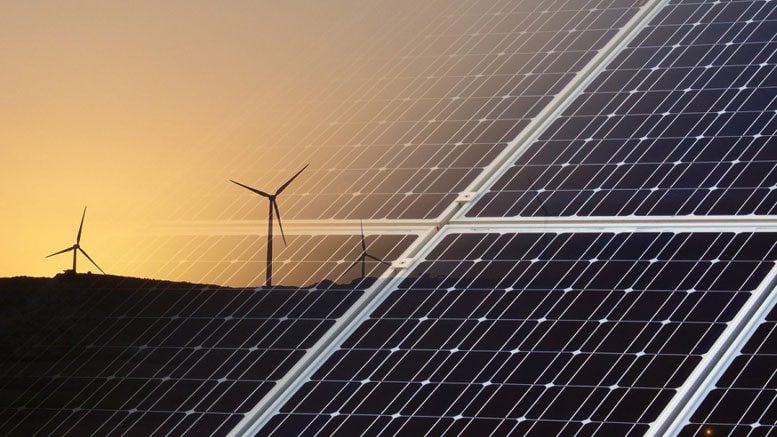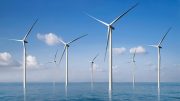Wind and solar power could generate most but not all electricity in the United States, according to an analysis of 36 years of weather data by Carnegie’s Ken Caldeira, and three Carnegie-affiliated energy experts: Matthew Shaner, Steven Davis (of University of California Irvine), and Nathan Lewis (of Caltech).
Right now, about 38 percent of carbon dioxide emissions come from electricity production, which must be reduced to combat climate change.
The team found that as the amount of electricity produced by solar and wind increases, avoiding major blackouts becomes increasingly challenging. Policymakers and planners need to consider that wind and solar resources will have natural variability, the team said.
“Our team took a simplified approach aimed at understanding fundamental geophysical constraints on wind and solar power,” explained lead author Shaner. “We looked at solar and wind power availability on an hourly basis across the U.S. and determined how much of current electricity demand could be met by varying amounts of solar panels, wind turbines, and energy storage, in addition to changes in the electricity grid.”

Figure S 14| R2 of correlations between hourly wind and demand, and solar and demand, data. In all cases, demand data is from 4 July to 31 December 2015. Correlations are calculated for wind and solar generation data for 4 July to 31 December of each listed year. Note that year 2015 is not an outlier, indicating that the differences in correlations coming from cycling of demand data are unlikely to substantially affect our results. Matthew R. Shaner, et al., “Geophysical constraints on the reliability of solar and wind power in the United States,” Energy Environ. Sci., 2018; doi:10.1039/C7EE03029K
According to the team’s findings, solar power resources reached peak generating ability in June and July, and wind resources peak in March and April and slump during July and August. So, the resources have a complementary effect that would allow each to help alleviate the other’s deficiencies. But this wouldn’t be enough to overcome the non-seasonal variation in solar and wind resources.
Their assessments showed that reliable electricity generation with 80 percent solar and wind would require a continent-scale transmission grid with at least 12 hours of storage to overcome ordinary day-to-day variation.
But to bump up to 100 percent of electricity coming from solar and wind power would require significantly greater and costlier energy infrastructure changes to overcome seasonal cycles and extreme weather events. It would be necessary to have either the capacity to store the generated electricity for several weeks—something not economically feasible today—or the ability to generate a surplus of electricity, much of which would be infrequently used. Likewise, a continent-scale transmission grid would also be required.
“Our work indicates that wind and solar would need to be supplemented by some kind of dispatchable power like natural gas or huge amounts of storage,” Caldeira added. “Natural gas emits greenhouse gases and the storage is super expensive, so we need a search for better ways of supplying electricity when the sun is not shining, and the wind is not blowing.”
Reference: “Geophysical constraints on the reliability of solar and wind power in the United States” by Matthew R. Shaner, Steven J. Davis, Nathan S. Lewis and Ken Caldeira, 27 February 2018, Energy Environmental Science.
DOI: 10.1039/C7EE03029K










Great article. Finally someone talking about the real limitations of Green power. For wind and solar power to be feasible, there must be much better methods to store the electricity they produce. Until there are better storage methods, fossil power will have to remain as the back-up. It is very costly keeping fossil plants on stand-by for periods when the wind does not blow or the sun does not shine.